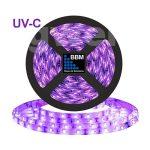UVC-LEDs replacing low-pressure mercury (LP-Hg) lamps in purification/disinfection systems
In the UVC LED market, the race for the highest WPE is on – WPE being the fraction of electrical power into the LED that is converted to optical power out of the device. In this race, Bolb Inc. is roaring ahead.
Following the outbreak of COVID-19, ams OSRAM is already positioning itself as a leader with one of the best UVC LEDs in the market.
Used for more than 40 years for their germicidal effects, systems based on low-pressure mercury lamps (LP-Hg lamps) for surface, air, and water disinfection will gradually disappear in favor of UVC LEDs.
The Minamata Convention on Mercury (a global treaty that aims to protect human health and the environment from the harmful effects of mercury), future regulations, and lack of competing technology should allow UVC LEDs to take over the market, just as white light LEDs did a few years earlier in the general lighting segment.
The adoption of this technology for this purpose is, therefore, no longer a question of “if” but “when.”
As with white-light LEDs, wall-plug efficiency is considered the champion parameter that will, at a specific level, help bring LP-Hg lamps to an end.
However, for the time being, most UVC LED WPEs are in the range of 1 – 4%, too low to compete with LP-Hg lamps which have an efficiency of around 30%
“This creates a cascade effect with, as an end result, a consequence on the cost: the lower the efficiency, the higher the quantity of heat to be dissipated, the more difficult the integration and the higher the cost,” says analyst Matthieu Verstraete, “yet, a few companies are beginning to stand out with promising WPEs”.
Nichia provides an LED with WPE > 5%, although for a 280 nm wavelength which has a lower germicidal effect. Bolb Inc. and ams OSRAM fare well with an efficiency > 5.5% at 265 nm, the optimum wavelength for this application.
The interesting fact remains that the global leader in optical solutions introduced its product, which bears an uncanny resemblance to Bolb’s design, a few months after acquiring 20% of Bolb Inc., leaving no doubt as to the device’s origin. Still, with its patented transparent chip UVC LED structure, Bolb Inc., the newcomer, is ahead of the competition with four products featuring between 5.5 and 6.4% efficiency.
Cost
Despite a significant decrease between 2016 and 2021 (factor of 200), the cost of UVC LEDs remains high compared with LP-Hg lamps ($0.05/mW versus ~$0.002/mW). However, it is approaching a sufficiently high level to intensify interest in bringing the product to the market.
Lifetime
Although already superior to LP-Hg lamps (12,000 h against 8,000 h), the lifetime remains a parameter to be improved to offset the purchase cost by a longer operating time and, therefore, a lower maintenance cost.
Holding all the cards, PISÉO considers that UVC LEDs could feature a WPE equivalent to that of LP-Hg lamps and a lifetime equal to that of white light LEDs (50,000 h) by 2028.
The challenge is in combining all the best parameters – high WPE, low cost, high lifetime, at the optimal wavelength – in one device – with different strategies, the solutions developed by the major players should eventually converge toward the ideal UVC LED. The analysis determines the tipping point at which it is more cost-effective to invest in UVC LEDs than in LP-Hg lamps. This total cost of ownership analysis takes into account the evolution of power consumption and the amortization of the UVC source according to its price and lifetime.
After a few years of timid achievements, the COVID-19 pandemic has driven optical players out of hiding.
Many announcements have been made recently. Last month, Bolb Inc. boasted a WPE of 8.3% on UVC LED prototypes, while Crystal IS claimed a projected L70 lifetime value of over 25,000 hours for its latest generation product.
Samsung, which has recently entered the market, could show some exciting achievements this year. More announcements are expected, confirming the intense activity in the field.
View more : IGBT modules | LCD displays | Electronic Components